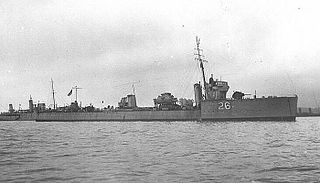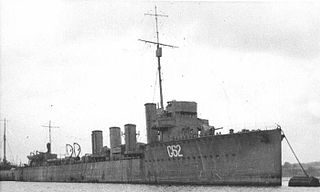
HMS Ithuriel was a Marksman-class flotilla leader of the British Royal Navy. Originally to have been named Gabriel, the name was changed before her launch. The ship was built by Cammell Laird at Birkenhead, being launched on 8 March 1916 and entering service in August that year. Ithuriel served with the Grand Fleet during the First World War, leading both a destroyer flotilla and a submarine flotilla. She survived the war, before being sold for scrap on 8 November 1921.
HMS Faulknor was a British destroyer of the First World War. She was purchased by the Royal Navy whilst still under construction in Britain for the Chilean Navy who had ordered her in 1912 as part of the Almirante Lynch class. She was renamed after the Faulknor family of British nineteenth century naval officers.

HMS Valentine was a V and W-class destroyer, built in 1917 for the Royal Navy. She fought in both world wars, serving in several capacities. She was heavily damaged by air attack and beached in 1940 near Terneuzen. Her hulk remained there until it was broken up in 1953.

HMS Porpoise was an Acasta-class destroyer of the Royal Navy, which was built by Thornycroft between 1912 and 1914. Porpoise served through the First World War, taking part at the Battle of Jutland in 1916, where she was damaged. In 1920, she was sold to the Brazilian Navy serving under the name Alexandrino de Alencar and was renamed Maranhão in 1927. Maranhão remained in service when Brazil entered the Second World War, being used for patrol and convoy duties. She was disposed of in 1945.

HMS Cockatrice was an Acasta-class destroyer of the British Royal Navy. She was built by Hawthorn Leslie and Company, launching in 1912 and served throughout the First World War. She was sold for scrap in 1921.

HMS Marksman was a Marksman-class flotilla leader of the British Royal Navy. Construction at Hawthorn Leslie's Newcastle upon Tyne shipyard began in 1914, shortly before the outbreak of the First World War, and the ship was launched and completed in 1915. She took part in the Battle of Jutland in 1916 and survived the war. She was sold for scrap in 1921.

HMS Nimrod was a Marksman-class flotilla leader of the British Royal Navy. She was built by the Scottish shipbuilder Denny, with construction starting in 1914 and completed in August 1915. She served through the remainder of the First World War. She was sold for scrap in 1921.
HMS Lightfoot was a Marksman-class flotilla leader of the British Royal Navy. Construction by J. Samuel White began in June 1914, shortly before the outbreak of the First World War, and the ship was launched and completed in 1915. She survived the war and was sold for scrap in 1921.

HMS Rob Roy was a Royal Navy R-class destroyer constructed and then operational in the First World War. The ship served in the Grand Fleet as part of the Fifteenth Destroyer Flotilla.

HMS Kempenfelt was a Marksman-class flotilla leader of the British Royal Navy. She was built by the Cammell Laird at their Birkenhead shipyard, with construction starting in 1914 and completed in August 1915. She served through the remainder of the First World War. She was sold for scrap in 1921.
HMS Gabriel was a Marksman-class flotilla leader of the British Royal Navy, that took part in the First World War. The ship was built by Cammell Laird at Birkenhead, being launched on 23 December 1915 and entering service in July 1916. Gabriel served with the Grand Fleet, leading a destroyer flotilla and was later used as a minelayer. She survived the war, before being sold for scrap on in May 1921.
HMS Grenville was a Parker-class flotilla leader of the British Royal Navy. She was built by Cammell Laird during the First World War, being launched on 17 June 1916 and completing on 11 October that year. Grenville served with the Grand Fleet for the rest of the war, which she survived. The ship took part in operations in the Baltic during the Russian Civil War in the winter of 1919–1920, before entering a long period of reserve. She was sold for scrap in December 1931.
HMS Parker was a Parker-class flotilla leader of the British Royal Navy, and the lead ship of her class. She was built by Cammell Laird during the First World War, being launched on 16 August 1916 and completing on 13 December that year. Parker served with the Grand Fleet for the rest of the war, which she survived. The ship was sold for scrap in November 1921.
HMS Saumarez was a Parker-class flotilla leader of the British Royal Navy. She was built by Cammell Laird during the First World War, being launched on 14 October 1916 and completing on 21 December that year. Saumarez served with the Grand Fleet for the rest of the war, which she survived. The ship was sold for scrap in January 1931.

HMS Rocket was an R-class destroyer which served with the Royal Navy during World War I. Launched on 2 July 1916 after being stuck on the slipway since 30 June, the ship joined the Grand Fleet, operating as part of a destroyer flotilla undertaking anti-submarine operations in the North Sea. Although the ship did not successfully engage any German submarines, there was an incident with the Royal Navy boat K7 on 16 June 1917, although that attack was aborted after the erstwhile target was identified as a friendly vessel. After the War, the destroyer served with the anti-submarine and torpedo schools at Portsmouth, and briefly during the Chanak Crisis of 1922, before being sold to be broken up on 16 December 1926.

HMS Peregrine was a Admiralty M-class destroyer that served with the Royal Navy during the First World War. The M class were an improvement on the preceding L class, capable of higher speed. Launched on 29 May 1916, the vessel served with the Grand Fleet, focusing on anti-submarine warfare. In 1917, the destroyer was involved in the search for UC-65 after the submarine had sunk the protected cruiser Ariadne. In 1918, the ship participated in one of the final sorties of the war, although this did not lead to a confrontation with the German High Seas Fleet. After the Armistice that ended the war, the destroyer was placed in reserve and subsequently sold to be broken up on 9 May 1921.

HMS Penn was a Repeat Admiralty M-class destroyer which served with the Royal Navy during the First World War. The M class were an improvement on the preceding L class, capable of higher speed. The ship was named after William Penn, the father of the founder of Pennsylvania. Launched on 8 April 1916, the vessel served with the Grand Fleet forming part of the screen for the dreadnought battleships of the 1st Battle Squadron and escorting the aircraft carrier Furious in battle. The destroyer participated in the Actions of 19 August 1916 and 16 October 1917, as well as forming part of the distant support during the Second Battle of Heligoland Bight. Penn was also instrumental in rescuing the survivors from the light cruiser Nottingham, sunk by a German submarine. After the Armistice that ended the war, the destroyer was placed in reserve and subsequently sold to be broken up on 9 May 1921.

HMS Opportune was an Admiralty M-class destroyer which served in the Royal Navy during the First World War. The M class were an improvement on the previous L-class, capable of higher speed. The vessel was launched on 20 November 1915 and joined the Grand Fleet. Opportune spent much of the war involved in anti-submarine warfare. The ship took part in large patrols to seek out submarines which involved entire flotillas and also acted as an escort for convoys. After the Armistice that marked the end of the First World War, the destroyer was transferred to Portsmouth and placed in reserve. After a brief spell as a remote controlled target to test how warships responded to attacks by aircraft, Opportune was decommissioned and, on 7 December 1923, sold to be broken up.

HMS Oberon was a Repeat Admiralty M-class destroyer which served in the Royal Navy during the First World War. The M class were an improvement on the previous L-class, capable of higher speed. The vessel was launched in 1916 and joined the Grand Fleet. Oberon joined the Thirteenth Destroyer Flotilla which, in 1917, participated in a large anti-submarine warfare operation in the North Sea. The sortie led to three German submarines being sunk, although Oberon was not directly involved in these attacks. In 1918, the flotilla was involved in one of the final sorties of the Grand Fleet, but again the destroyer saw no action at the time. After the Armistice that marked the end of the First World War, Oberon was placed in reserve, decommissioned and, in 1921, sold to be broken up.

HMS Onslaught was a Admiralty M-class destroyer which served with the Royal Navy during the First World War. The M class were an improvement on the previous L-class, capable of higher speed. The vessel, launched in 1915, joined the Twelfth Destroyer Flotilla under the flotilla leader Faulknor. The ship saw action during the Battle of Jutland in May 1916, jointly sinking the German torpedo boat SMS V48 and launching the torpedo that sank the pre-dreadnought battleship Pommern, the only German battleship to be lost in the battle. Subsequently, the destroyer acted as an escort to other naval ships during the Action of 19 August 1916 and took part in anti-submarine operations. At the end of the war, Onslaught was withdrawn from service and, in 1921, sold to be broken up.











